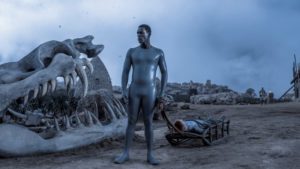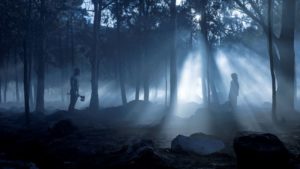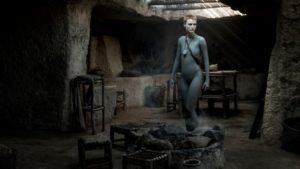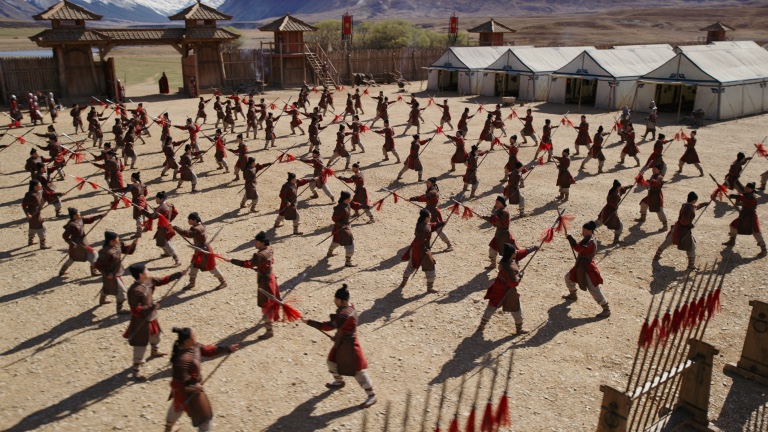
In the spring of 2019, Production Designer Chris Seagers and Director Ridley Scott were embroiled in a film project when Scott asked Seagers to initiate the design on the futuristic science-fiction project Raised by Wolves, which Scott was executive producing through his Scott Free production company. “We segued straight onto that,” Seagers said of the new series, which is available on HBO Max, WarnerMedia’s streaming service. “Ridley is busy with other things—in order to get him going, I came in and set it up for Ridley.”
When Scott first agreed to oversee Raised by Wolves, he and Seagers contemplated a physical location in which to establish the series—one with an arid, hostile environment. “We were thinking about Iceland and Morocco, Spain: the usual suspects,” Seagers divulged. “I got sent off to South Africa. He gave me three days to find a general look.”
In South Africa’s Western Cape province, Seagers located a large state farm with an old vineyard in which buffalo graze on grassland, peppered with old pine trees. “If they allow us to strip the topsoil off, we could create a set on this sandy base, as long as we put it back the way we found it,” Seagers described. “I sent a lot of pictures back to Ridley. He responded to the mountains—almost 180 degrees around us—and the skies.”
Though Seagers had a modest budget, much of his resources went into building the main location set, with nine weeks of preparatory time. “It almost gave us 360˚—you can shoot around it,” Seagers stated. “It gave you the freedom to do what you like. We put the rocks in and got hundreds of those trees. It was cheaper to buy them, and ship them from Namibia, and bring them all in by truck. We did make a lot as well—mixing real with artificial helps the look; the real ones are the smaller ones. We cast the real ones, and augmented the cast, and made them taller, and bigger girth in the trunk.”
In constructing the sets, Seagers recalled a dictum from his executive producer/director. “When we first started, Ridley wanted to have something that gave it some geography,” said Seagers of the environments he devised. “Otherwise, you don’t know where you are. It can all look same-y.”

Additionally, Seagers’ crew excavated large areas, so that an actual gigantic crevasse was created for a sequence where a spaceship falls onto its precipice. “There were mining laws in South Africa—we had to be careful not to go any deeper before we had to get a license for mining,” Seagers recalled. “We actually dug a 25-30-foot hole and put the real spaceship on the edge of it. Ridley likes to go physical—it helps with the light and creating the environment.”
For more intimate scenes, Seagers also built sets on Capetown’s ample soundstages. “We ended up building the entire home [the main characters] created for the kids,” he said, noting that he only supervised the design for two of the series’ episodes—the specific ones also directed by Scott. “We built it on location and again on stage; we split it half-and-half. When you are working with Ridley, he works at quite a pace.”
After Seagers launched the looks for Raised by Wolves, Production Designer Tom McCullagh was brought aboard the remainder series from Belfast, in the North of Ireland. “I had worked with Scott Free on a job in Morocco called Killing Jesus,” McCullagh said. “I thought it was a great opportunity. Where Chris left off, I moved on. Ridley’s son Luke directed [episodes] three and four and ten. I had worked with Luke on a feature in Northern Ireland called Morgan—it was sci-fi as well.”
Jumping into the show, McCullagh observed the series’ sets and machinations to carry it forward, largely with local crews in South Africa. “The construction crews, props crews were amazing,” McCullagh stated of the 150 craftspeople in his department. “I found them very easy to get on with and communicate with—they had great ideas, and the quality of work from construction was fantastic. I had one art director that I brought over with me.”

With episodes one and two in the can under Seagers’ supervision, McCullagh had scripts for installments three and four many weeks ahead of principal photography. “Luke came over four-five weeks out to prep before they shot,” McCullagh relayed. “It was a tight time scale once the script arrived, and the director hit the ground rolling. Number ten: most of that was shot on the landscape set in two studios. Because of time constraints, I had to jump ahead before Luke came on board. When he did come on board, with a few tweaks, we got it to work.”
Given his nine months in South Africa, McCullagh was fully immersed in the visual development of Raised by Wolves’ universe. “I hadn’t really done anything like that before, on that scale,” he revealed. “You are trying to invent the future, as it were. The spaceship, where it crashes, that becomes a key. You are trying to create something different. Large plane crashes were studied.”
In his fashioning of key elements for the year 2145, McCullagh unveiled that the spaceship presented a prominent challenge on Raised by Wolves, one for which Ridley Scott offered suggestions. “Everything would be radio waves and nuclear power, fusion power, all very technical stuff,” said McCullagh. “We created a honeycomb shell that made up the body. A fireball had gone through the entire ship. It was a quite a challenge, but a good challenge.”





